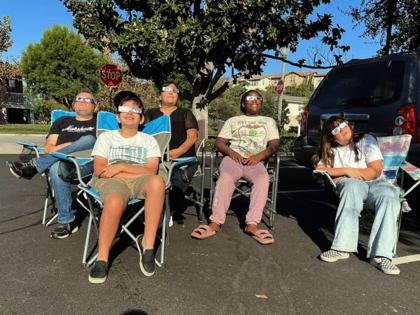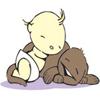Solar eclipse thrills crowds in California as it darkens swath of countryside
Published in Science & Technology News
LOS ANGELES — Nancy Castellanos and her 5-year-old daughter, Camilla, sat on a striped picnic blanket outside the California Science Center with their eyes fixed to the sky.
Castellanos, 39, reminded her daughter not to look up without protective eclipse glasses. It was Camilla’s first time experiencing the phenomenon of a solar eclipse. They waited and watched as the moon began streaking across the sun, taking a chunk out of the bright mass. In Los Angeles, at the eclipse’s peak, about 50% of the sun will be blocked.
“It’s such a memorable event, especially for the children,” Castellanos said as Camilla cuddled in her lap. “She can remember this later on and watch the next one too.”
Millions of people across the United States collectively looked up at the sky Monday to witness a rare total solar eclipse. And although California didn’t experience the phenomenon of totality, there was still plenty to see.
A total solar eclipse happens when the moon passes between the sun and the Earth, completely blocking the face of the sun and casting a shadow across a wide strip of the planet below. For people in that strip, known as the path of totality, the sky will become dark as night and the temperature might drop.
Outside the path of totality, people on the daylight side of the globe will experience a partial eclipse in which the moon covers a portion of the sun. In Los Angeles, this will be visible starting at 10:06 a.m.
A substantial blocking of the sun will be obvious by 10:39 a.m. and will peak at 11:12 a.m. By 12:22 p.m., it will be over, according to the Griffith Observatory.
“It’s an opportunity to see firsthand our place in the universe,” said Paul Robertson, an associate professor of physics and astronomy at UC Irvine. “We’re sitting on the surface of this rock that’s careening through space at a speed of 30 kilometers per second, and we’re doing this sort of gravitational dance with these other giant bodies.”
During a partial solar eclipse, we can see the Earth, sun and moon “at the same time interacting in a way that they usually don’t,” Robertson said.
Unlike elsewhere in the country, where cloudy skies risk spoiling the view for eclipse chasers, forecasters are predicting a sunny, clear day in Southern California. Downtown Los Angeles is expected to see temperatures in the mid-70s. The mercury could temporarily drop a few degrees during the actual eclipse because of the reduction in solar radiation, said Kristan Lund, a meteorologist with the National Weather Service.
...continued
©2024 Los Angeles Times. Visit at latimes.com. Distributed by Tribune Content Agency, LLC.







Comments